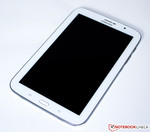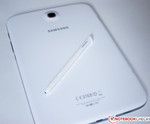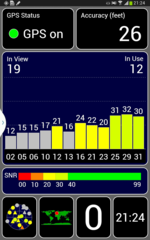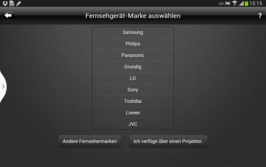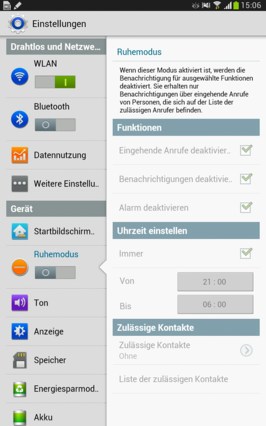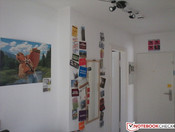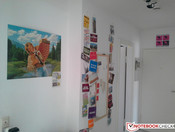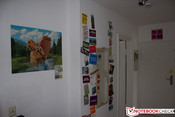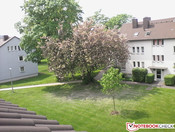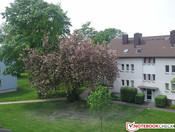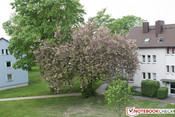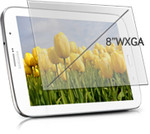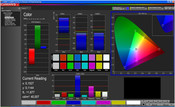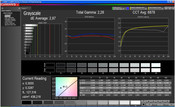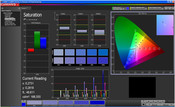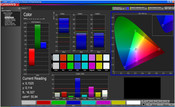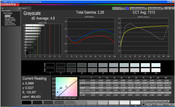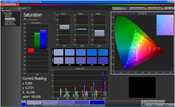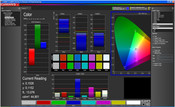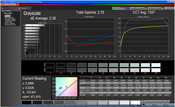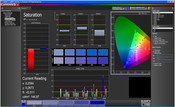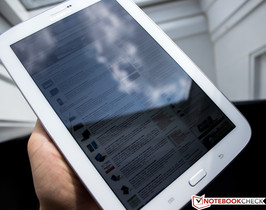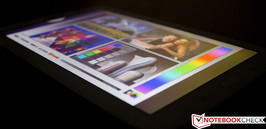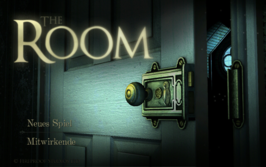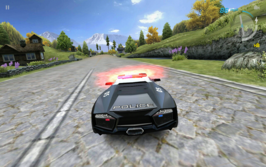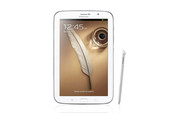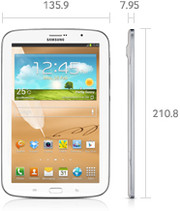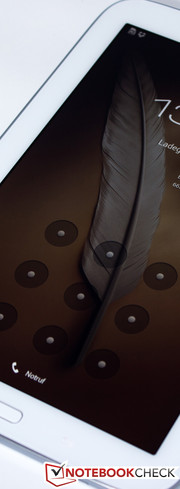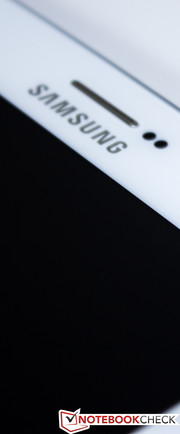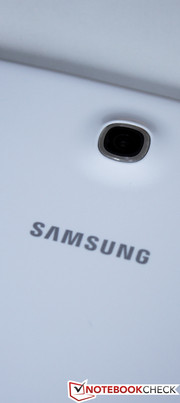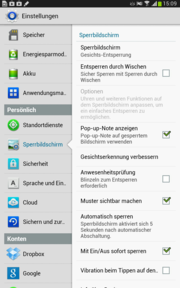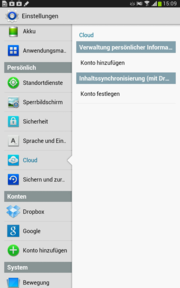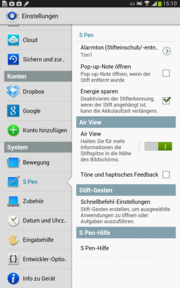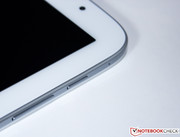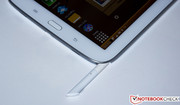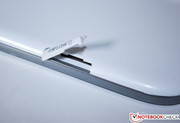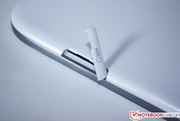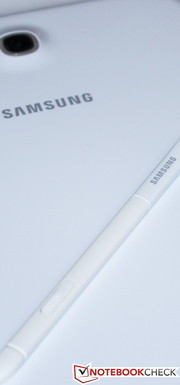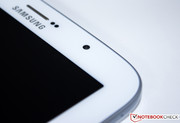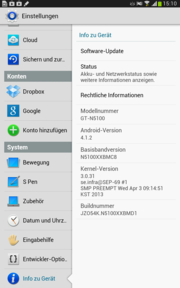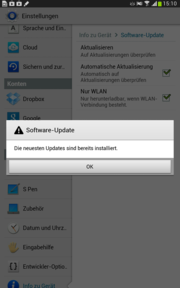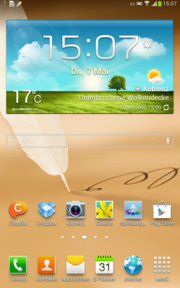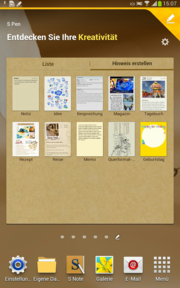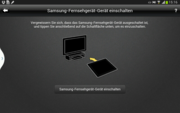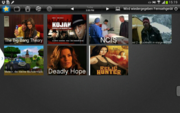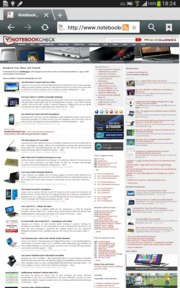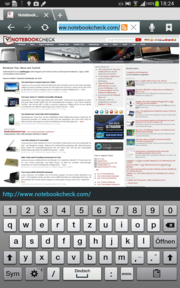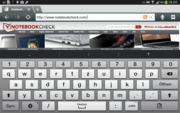Review Samsung Galaxy Note 8.0 Tablet
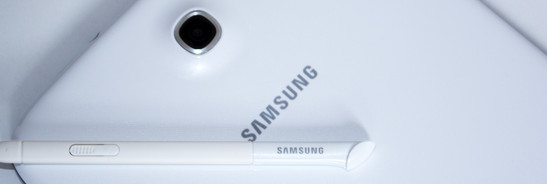
For the original German review, see here.
Samsung's Galaxy Note series has incorporated very large displays and high-end hardware since their inception and the N7000 smartphone. The Galaxy Note 8.0 rounds out the portfolio and sits between the 10.1-inch Note 10.1 and the 5.5-inch Galaxy Note II. Compared to its bigger brother, the new ‘tabphone’ uses Samsung's own Touchwiz interface - but more on that later.
Samsung doesn't skimp on the hardware. The polycarbonate shell contains top-notch components like the 1.6 GHz Exynos 4412 Quad-Core-SoC, 2 GB of RAM, and the ARM-based Mali 400 MP4 GPU. The Galaxy Note III will - at least according to rumors - feature a FullHD display. The Note 8.0 comes with the HD panel and a resolution of 1280 x 800 pixels. The new model ships with Google's Android 4.1 (Jelly Bean) OS. An update to 4.2 is expected - although at the time of writing, a release date hasn't been announced yet. In our review, we will evaluate how well Samsung's new tablet and smartphone hybrid performs and what notable features it offers.
Case
Users familiar with the Galaxy S or Galaxy Note series know what to expect - and the new model is visually almost identical. Just like for the flagship S4, Samsung relies on plastic for the display frame, the hardware buttons, the back, and the case itself. Opinions differ on this topic, although the number of units sold speaks in Samsung's favor, many potential buyers turn to a different manufacturer for this very reason. The Note 8.0 is certainly not flimsy or appears cheap but models like the HTC One have a more upscale feel to them. Overall, the tablet is sturdy. It resists twisting pretty well and the back cover doesn't deform much when pressure is applied.
The tablet measures 210.8 x 135.9 x 7.95 millimeter - a little less wide and thinner than the Easypix SmartPad EP800 (204 x 156 x 10.2 millimeter) which has the same display size. The Note 8.0 weighs only 340 grams and is therefore significantly lighter than the tablet from Easypix and about as heavy as the 7-inch Asus Fonepad.
Connectivity
Connectivity options between the different models of the Note-series are also nearly identical. The top is home to a 3.5 millimeter audio jack while the right side houses the power button and the rocker switch for the volume control. The bottom is home to the Micro-USB port which allows charging the tablet or connecting it to a PC. A distinguishing factor is the S Pen which can be stored neatly inside the case itself. The left side has slots for the MicroSD and Micro-SIM cards. Somewhat surprisingly, the manufacturer from South Korea has also included an infrared port - once a standard for all phones but long since surpassed by Bluetooth. We will talk about the reason for the revival a little later.
Our review model comes with 16 GB of internal storage (9.78 GB available) which can be expanded with the aforementioned MicroSD card slot.
Communication & GPS
The Note 8.0 is equipped with the common communication modules like Bluetooth 3.0, WLAN 802.11 a/b/g/n, and UMTS/HSPA with speeds up to 21 Mbps. We never had any issues like communication drops during our time with the tablet. The GPS module also established satellite reception quickly and proved to be highly accurate.
Telephony
Not all tablets which can be equipped with a SIM card can be used as phones. Frequently, the SIM card only allows for Internet connectivity. That's not the case with the Note 8.0. A phone widget is pinned to the home screen. Thanks to Touchwiz, users familiar with Samsung devices as well as new users will find their way around quickly as the operation is intuitive and straight forward.
Software
When we turned on the Note 8.0 for the first time, we expected an OS tailored for tablet use similar to the Note 10.1. Instead, we were greeted with a smartphone-typical home screen and appearance - courtesy of Touchwiz. At this point, we have to ask the question: are we dealing with an overly large smartphone or a tablet that's styled like a smartphone?
Samsung adapted and modified the software. There are additional options in the system settings like "quiet mode" and "S Pen" for example. Samsung also includes their typical software like Allshare Play, ChatON, Game Hub, and Smart Remote. Some applications can be uninstalled but not all of them.
The application Smart Remote makes use of the infrared port we previously mentioned. The tabphone can be used as a universal remote if so desired. We tried this functionality with a Smart TV from Samsung. Although it appears to us that the application is still a bit rough around the edges, the initial connection and initialization worked without a hitch.
Cameras & Multimedia
The tablet comes with two camera modules. The main, rear-facing camera has a resolution of 5 MP and the front-facing camera 1.3 MP. The front camera can also be used to unlock the device as software for facial recognition is included. As long as the ambient brightness is sufficient, recognition works well.
The photo quality is acceptable but far from outstanding. The sensor has issues with darker environments and image noise can be an issue while sharpness could also be better. Photos taken with the front-facing camera suffer from even more image noise and a loss of detail. Outside, the picture quality is much better; noise is now not an issue and sharpness increases. When comparing the photos to the shots taken with the reference camera, we noticed a slightly bluish cast. The front camera is not capable of producing vivid colors but given the small sensor, the results are still acceptable.
Accessories & Warranty
Samsung usually doesn't include a lot of accessories and the Note 8.0 is no different in this aspect. The box, which is made from 100% recycled materials, only includes a quickstart-guide and the modular power adapter. Despite the MSRP of 599 Euro (~$770), the manufacturer does not include anything else - not even a headset.
The included warranty card informs the user that Samsung provides a "24-month warranty against defects in material and workmanship". Accessories and the battery are covered for 6 months beginning from the date of purchase.
Input Devices & Operation
As we've come to expect from a Samsung device - operating it works as it should. Inputs are recognized and translated immediately and the touchscreen is very precise. For detail work - like painting or handwritten notes - the S Pen comes in handy. Operation of the pen is intuitive just like it is with the Galaxy Note 10.1 and Galaxy Note II. In addition to the touchscreen, the tablet has three physical buttons. Two are located on the right side; the third is the Android-specific home button. Samsung stays the course and does not use a soft key like many other competitors (for example, the Google Nexus 4 or the HTC One).
Display
Up to this point, Samsung had a gap in their performance-oriented Galaxy Note lineup. The Note II has a 5.5-inch screen, whereas the Note 10.1 - as the name implies - features a 10.-inch screen. The new model closes that gap with its 8-inch display. The capacitive touchscreen can be operated with the fingers or the S Pen and supports multitouch. Unfortunately, Samsung did not bump up the resolution. The display only supports HD at a resolution of 1280 x 720 pixels. The screen has an aspect ratio of 16:9 and a pixel density of 184 DPI.
| |||||||||||||||||||||||||
Brightness Distribution: 88 %
Center on Battery: 465 cd/m²
Contrast: 750:1 (Black: 0.62 cd/m²)
ΔE Greyscale 5.39 | 0.57-98 Ø5.3
Gamma: 2.76
We measured a maximum brightness of 465 cd/m² in the middle of display. The average brightness is an outstanding 449.2 cd/m² with a distribution of 88 %. The Asus Fonepad, which we recently reviewed, only reached 296.6 cd/m² and a distribution of 85%. High brightness like that is rather rare - although we occasionally do encounter it: the Asus Transformer Pad Infinity (534,6 cd/m²) comes to mind as an example. It would be great if the black value would follow suit - but 0.62 cd/m² is slightly too high, which results in a somewhat lower contrast of 750:1. The Fonepad has a black point of 0.3 cd/m² and a contrast of 1020:1.
The system settings allow for three different display modes which adjust the gray levels, saturation, and color accuracy accordingly. The movie mode shows the least amount of deviation from the ideal but there's still a distinct green cast and reds are too pale. In addition, the DeltaE 2000 value for blue reaches almost 20. For the movie mode, the actual deviation from the ideal is lowest for the gray levels. Only when brightness increases, the lack of presence becomes noticeable.
Since the display is extremely bright, the tabphone can be used outside without reservation. The glossy screen and the average contrast might negatively impact readability a bit - but not noticeably so.
Performance
Samsung uses up-to-date and powerful hardware for their Note series. The Note 8.0 comes equipped with 2 GB of RAM and an Exynos 4412 quad-core SoC. The four cores operate at 1.6 GHz and are supported by the ARM Mali 400 MP4 GPU which operates at 400 MHz. The internal flash storage offers a capacity of 16 GB (9.78 GB usable) and can be expanded using a MicroSD card. We've conducted several benchmark tests in three different categories to compare the performance to other quad-core tablets.
First, we subjected the tablet to synthetic benchmark tests. The results are convincing. Only in two tests, a competitor was able to top the results. The iPad Mini outscored the Note 8.0 by 17 % during the GLBenchmark 2.5 while the Asus Fonepad received a higher score for the Smartbench 2012 test. Even so, the performance of the Note 8.0 speaks for itself.
| GLBenchmark 2.5 | |
| 1920x1080 Egypt HD Offscreen Fixed Time (sort by value) | |
| Samsung Galaxy Note 8.0 | |
| Apple iPad mini | |
| Easypix SmartPad EP800 Ultra | |
| Bullman Tab 9 AQQ Revolution | |
| Samsung Galaxy Note II GT-N7100 | |
| Asus Fonepad ME371MG | |
| Egypt HD Fixed Time (sort by value) | |
| Samsung Galaxy Note 8.0 | |
| Apple iPad mini | |
| Easypix SmartPad EP800 Ultra | |
| Bullman Tab 9 AQQ Revolution | |
| Samsung Galaxy Note II GT-N7100 | |
| Asus Fonepad ME371MG | |
| AnTuTu v3 - Total Score (sort by value) | |
| Samsung Galaxy Note 8.0 | |
| Easypix SmartPad EP800 Ultra | |
| Bullman Tab 9 AQQ Revolution | |
| Asus Fonepad ME371MG | |
| NenaMark2 - --- (sort by value) | |
| Samsung Galaxy Note 8.0 | |
| Easypix SmartPad EP800 Ultra | |
| Bullman Tab 9 AQQ Revolution | |
| Samsung Galaxy Note II GT-N7100 | |
| Asus Fonepad ME371MG | |
| Geekbench 2 - 32 Bit - Total Score (sort by value) | |
| Samsung Galaxy Note 8.0 | |
| Apple iPad mini | |
| Easypix SmartPad EP800 Ultra | |
| Bullman Tab 9 AQQ Revolution | |
| Samsung Galaxy Note II GT-N7100 | |
| Asus Fonepad ME371MG | |
| Smartbench 2012 | |
| Gaming Index (sort by value) | |
| Samsung Galaxy Note 8.0 | |
| Easypix SmartPad EP800 Ultra | |
| Easypix SmartPad EP800 Ultra | |
| Bullman Tab 9 AQQ Revolution | |
| Samsung Galaxy Note II GT-N7100 | |
| Asus Fonepad ME371MG | |
| Productivity Index (sort by value) | |
| Samsung Galaxy Note 8.0 | |
| Easypix SmartPad EP800 Ultra | |
| Easypix SmartPad EP800 Ultra | |
| Bullman Tab 9 AQQ Revolution | |
| Samsung Galaxy Note II GT-N7100 | |
| Asus Fonepad ME371MG | |
| Vellamo Mobile Benchmark 2.0 | |
| HTML5 (sort by value) | |
| Samsung Galaxy Note 8.0 | |
| Easypix SmartPad EP800 Ultra | |
| Easypix SmartPad EP800 Ultra | |
| Bullman Tab 9 AQQ Revolution | |
| Asus Fonepad ME371MG | |
| Metal (sort by value) | |
| Samsung Galaxy Note 8.0 | |
| Easypix SmartPad EP800 Ultra | |
| Easypix SmartPad EP800 Ultra | |
| Bullman Tab 9 AQQ Revolution | |
| Asus Fonepad ME371MG | |
For our second set of tests, we checked the browser performance. Again, we are rewarded with superb performance which surpasses all other compared smartphones or tablets.
| Browsermark - --- (sort by value) | |
| Samsung Galaxy Note 8.0 | |
| Apple iPad mini | |
| Bullman Tab 9 AQQ Revolution | |
| Asus Fonepad ME371MG | |
| Google V8 Ver. 7 - Google V8 Ver. 7 Score (sort by value) | |
| Samsung Galaxy Note 8.0 | |
| Apple iPad mini | |
| Easypix SmartPad EP800 Ultra | |
| Bullman Tab 9 AQQ Revolution | |
| Samsung Galaxy Note II GT-N7100 | |
| Asus Fonepad ME371MG | |
| Sunspider - 0.9.1 Total Score (sort by value) | |
| Samsung Galaxy Note 8.0 | |
| Apple iPad mini | |
| Easypix SmartPad EP800 Ultra | |
| Bullman Tab 9 AQQ Revolution | |
| Samsung Galaxy Note II GT-N7100 | |
| Asus Fonepad ME371MG | |
| Peacekeeper - --- (sort by value) | |
| Samsung Galaxy Note 8.0 | |
| Bullman Tab 9 AQQ Revolution | |
| Asus Fonepad ME371MG | |
* ... smaller is better
We then used AndroBench 3 to evaluate the internal flash storage. This test records the sequential and random read - write performance. It appears that Samsung uses high performance flash storage. Random writes, for example, are about 84 % faster than what the flash of the Easypix SmartPad EP800 is capable of.
We mentioned it earlier. Samsung uses updated hardware for their Note series to set an example and our test results show the strategy works.
| AndroBench 3-5 | |
| Random Write 4KB (sort by value) | |
| Samsung Galaxy Note 8.0 | |
| Easypix SmartPad EP800 Ultra | |
| Easypix SmartPad EP800 Ultra | |
| Bullman Tab 9 AQQ Revolution | |
| Samsung Galaxy Note II GT-N7100 | |
| Asus Fonepad ME371MG | |
| Random Read 4KB (sort by value) | |
| Samsung Galaxy Note 8.0 | |
| Easypix SmartPad EP800 Ultra | |
| Easypix SmartPad EP800 Ultra | |
| Bullman Tab 9 AQQ Revolution | |
| Samsung Galaxy Note II GT-N7100 | |
| Asus Fonepad ME371MG | |
| Sequential Write 256KB (sort by value) | |
| Samsung Galaxy Note 8.0 | |
| Easypix SmartPad EP800 Ultra | |
| Easypix SmartPad EP800 Ultra | |
| Bullman Tab 9 AQQ Revolution | |
| Samsung Galaxy Note II GT-N7100 | |
| Asus Fonepad ME371MG | |
| Sequential Read 256KB (sort by value) | |
| Samsung Galaxy Note 8.0 | |
| Easypix SmartPad EP800 Ultra | |
| Easypix SmartPad EP800 Ultra | |
| Bullman Tab 9 AQQ Revolution | |
| Samsung Galaxy Note II GT-N7100 | |
| Asus Fonepad ME371MG | |
Games & Videos
Since our test results indicate ample performance, we would have been very surprised if video material or games would have posed a problem for the Note 8.0. We couldn't resist trying out a plethora of different 3D games from Need For Speed, Cut The Rope to Angry Birds - and the tablet handled them all equally well.
That's also true for HD video playback. All videos, some in FullHD (1080p), played without any lags or stuttering. For the test, we used MKV container files with a data rate of up to 6100 kBit/s.
Since Samsung uses its own Touchwiz launcher, the widget for telephony is located on the home screen. This seems to indicate that phone functionality is a dominant feature and not a stopgap solution. The sound quality is very clear and not marred by artifacts (as long as the reception is good enough). Our partner on the other end had no issues understanding us and vice versa. We really think that Samsung should have included a headset as holding a 8-inch tabphone to the ear is bound to get jeers and stares.
Emissions
Temperature
Temperatures are also well controlled. Under load, we measured 32.7 degrees Celsius on the front and 33.8 degrees Celsius on the back. When we played demanding games in landscape mode for extended periods of time, the back got quite warm at 45.1 degrees Celsius which was uncomfortable after a while, but no reason for concern. When the SoC is not subjected to load, the temperatures stay between 30.3 and 31.6 degrees Celsius. The power adapter reaches the highest temperature - we measured 47.2 degrees under load.
(-) The maximum temperature on the upper side is 45.1 °C / 113 F, compared to the average of 33.8 °C / 93 F, ranging from 20.7 to 53.2 °C for the class Tablet.
(±) The bottom heats up to a maximum of 44.7 °C / 112 F, compared to the average of 33.3 °C / 92 F
(+) In idle usage, the average temperature for the upper side is 31.6 °C / 89 F, compared to the device average of 30 °C / 86 F.
Speakers
The two speakers are located to the left and right of the Micro-USB port. They are not overly large and the sound reflects that. Up to about 70 % of the maximum volume, the sound is acceptable, even though the highs are slightly muffled. Above that, the speakers sound very distorted. It's much better to use an external solution in this case.
Energy Management
Power Consumption
At first glance, the values during idle (1.2 to 3.9 watts) look to be just about average. A comparison with the Easypix SmartPad EP800 which is quite similar shows this to be true. The EB800 needs only slightly more power (2.3 to 4.1 watts). Under load, the results are reversed. The Easypix tablet needs up to 1.6 watts less. The Note 8.0 with its power consumption of 6.2 to 9.2 watts is definitely not the most efficient 8-inch tablet.
| Off / Standby | |
| Idle | |
| Load |
|
Battery Life
The slightly higher power consumption under load has an effect on the battery life. We used the tool "Stability Test" and determined a battery life of 2 hours and 58 minutes. The Asus Fonepad lasts about an hour longer under the same conditions. To simulate a more realistic usage-scenario, we set the display brightness to 150 cd/m² and use a script to automatically browse different websites. It took 8 hours and 30 minutes before we had to plug the Note 8.0 back in. It took 3 hours and 40 minutes for the battery to reach a full charge. When the phone is idle, the battery life increases to 13 hours and 48 minutes - still short of the Fonepad which lasts almost 19 hours. Interestingly enough, the Galaxy Note II lasts longer on a charge, even though the hardware is nearly identical. The Note 8.0 does have a larger display, but also a battery with 68 % more capacity.
Verdict
During the course of our review, we've called the Note 8.0 a tablet, a smartphone, and a tabphone since we didn't quite know what to call the device. At this point, we are still not sure. The Note 8.0 is too large to be stuffed into a pocket but still claims to be a phone.
The Note 8.0 features top-notch hardware on par with the other tablets and smartphones in the Note-series. Testing shows that the performance is outstanding and good enough for first place in most categories. The display brightness is higher than average and the tabphone can be used outdoors even when it's sunny. To be perfect, the display would have to have a lower black level and higher contrast. The battery life could also be better. All in all, the Note 8.0 is a very interesting and pleasantly sized device. Although the MSRP is still 599 Euro (~$770), we were able to find the padphone for around 460 Euro (~$595) online. The Note 8.0 fills the gap between the Note II and the Note 10.1 and neatly rounds out Samsung's Note portfolio. In our opinion, the Galaxy Note 8.0 is quite impressive and we see a lot of potential in this alternative to the Apple iPad Mini
Users who want to save some money and don't need phone functionality can also opt for the WiFi-only version which can be found for around 380 Euro (~$490).


 Deutsch
Deutsch English
English Español
Español Français
Français Italiano
Italiano Nederlands
Nederlands Polski
Polski Português
Português Русский
Русский Türkçe
Türkçe Svenska
Svenska Chinese
Chinese Magyar
Magyar